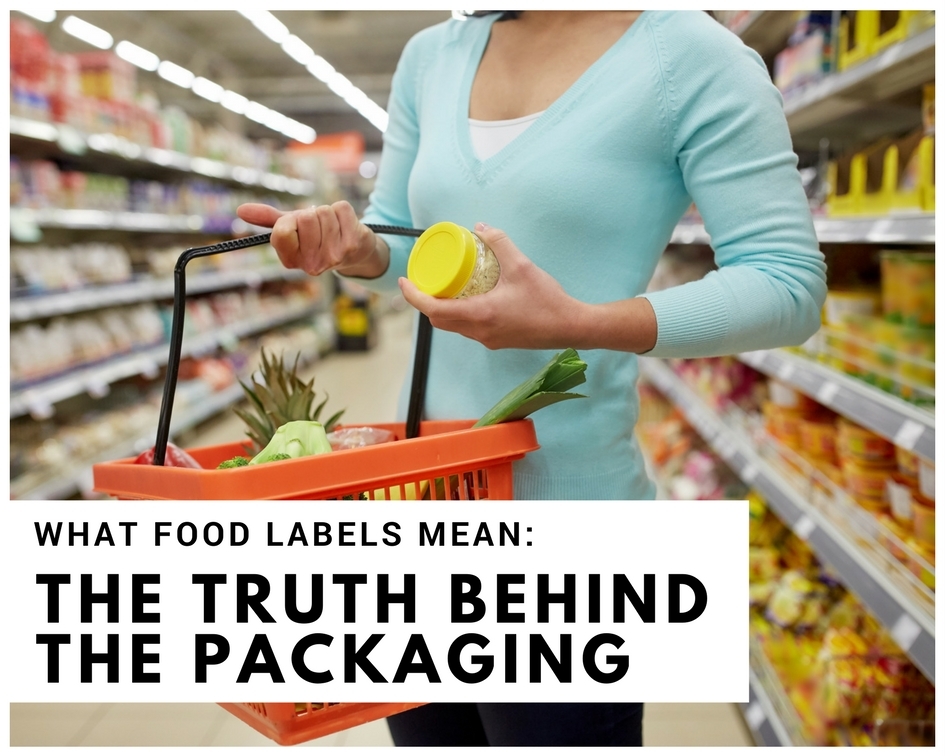Did you know that the traditional nutrition facts label (the black and white label on the back of the package), is the only labeling on the entire package that is regulated at all? The advertisements on the front of the package – you know the ones you see first – can actually be deceptive. Here’s what you need to know about these package labels when it says:
-FREE
No not free for you to take, but words like fat-free, sugar-free, salt-free, and calorie-free. The FDA does set standards which companies must comply with if they chose to use this labeling. Remember, however, that just because something is free from sugar, fat, or salt does not mean it’s calorie free.
And furthermore, it doesn’t mean it’s a healthy product. Sugar-free products are coming under more scrutiny for the potential adverse effects of artificial sweeteners on the microbiome. Fat-free products are often packed with added sugar to make it taste good.
If a product claims to be calorie-free, it must contain five calories or less per serving. Keep in mind it’s best to watch those serving sizes. Companies can put tiny unrealistic serving sizes down to comply with this labeling law.
LOW
Low-calorie, low-sugar, low-salt, or low-calorie labeling is also regulated. In this case, what the label means is that you can consume several servings of the product and you are unlikely to exceed the dietary recommendations for that nutrient.
For example, if you purchase low-fat ice cream, you could probably eat several bowls before even coming close to the recommended daily fat allowance. However, again, portion size and calories still need to be considered. Just because it’s low fat doesn’t mean it’s low calorie, etc. Low-calorie items are required to yield 40 calories or less per serving, however, serving size is still dependent on the company.
No Trans Fat
This one is TRICKY! The package can claim no trans-fat, and the food label can even say 0g of trans fat, but that often doesn’t mean it’s the truth. Always read the ingredients. If you see something with partially hydrogenated in the list, the product has trans-fat despite what the labeling says.
According to FDA, the amount may be “physiologically irrelevant,” but trans-fats are known to worsen your cholesterol (lowers your good cholesterol and increases your bad cholesterol) and have deleterious effects on your body. Best to avoid them at all costs.
Healthy Claims
Keep in mind that a company can argue that anything helps you to support or maintain your health in a certain way. However, they cannot make claims it will improve your health.
Do you know the difference between food that strengths your immune system and one that supports your immune system? There is no difference, but a simple change in wording makes one allowed and the other not. If food needs to make a health claim about itself, it likely is one that shouldn’t be purchased.
Natural
There is no regulation; the manufacturer typically decides when they believe this is an appropriate label. Proceed with extreme caution.
Fresh
Fresh means that the product cannot be processed, frozen or thawed. It does not refer to the length of time that product or item sits on the shelf.
Organic
This labeling term can refer to produce or animal products. For food to qualify, it cannot have been treated with conventional pesticides, fertilizers, or sewage. However, keep in mind, they do still use pesticide, naturally derived poisons and pesticides.
If you are wondering which is worse or better, the jury is still out. Experts disagree and research is unclear. Looking at things like the Environmental Working Groups Dirty Dozen list can help reduce your exposure without breaking the bank. Organic animal products cannot come in contact with antibiotics or growth hormones. Variations in organics, also exist, a product can be 100% organic, organic meaning 95%, or made with organic ingredients meaning it is about 70% organic.
This list is far from comprehensive. Make sure to always do your research before falling for package labeling schemes. One of our personal favorite, most deceptive labeling schemes is the use of the word “multigrain.” Sounds healthy right? Well, this just means more than one type of grain it doesn’t signify the product contains whole grains. Often if you look at the ingredients on a multigrain product the first ingredient is bleached, refined flour. When in doubt, always read the ingredient list.
